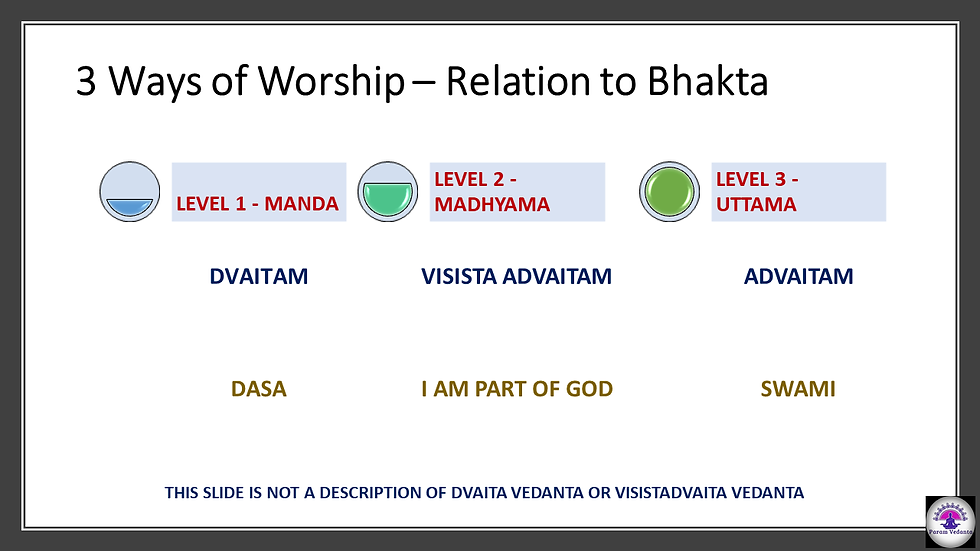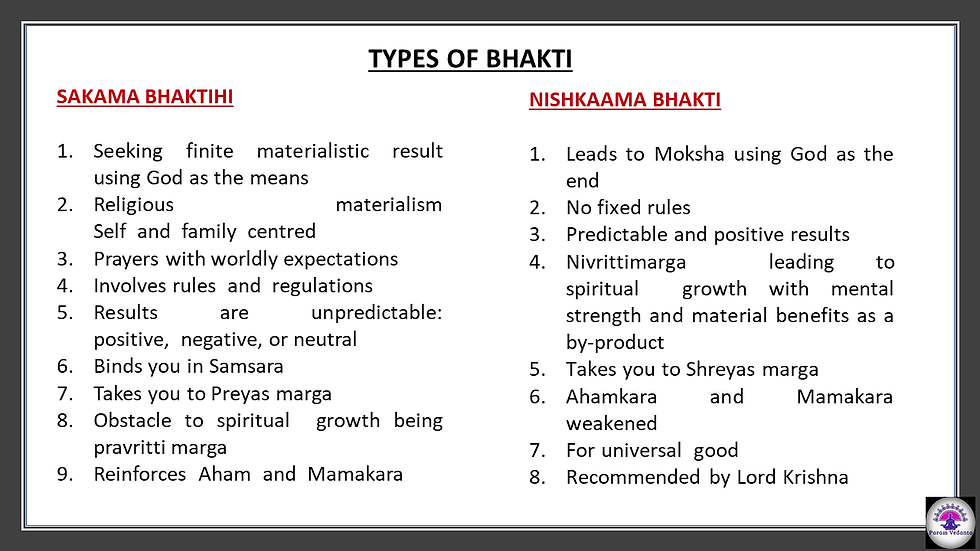Contributed By Dr T Hegde
Recap...
Akṣhara Brahma Yoga
Contributed By Dr Ravishankar




Rāja Vidyā Raja Guhya Yoga
9th chapter is very similar to Chapter 7, on sadyo-mukti .
Verses 4 to 10 is the Essence of the Upanishads.
Cause for suffering (samsara)
Ignorance of formless God , so invest on apara.
Bhakti is given as a remedy for the problem of samsara.
•Jnanam te’ham savijnanam- I’ll tell you about jnanam along with vijnanam
•Aham jnanam vaksyami- I shall impart knowledge
•Asesatah- thoroughly, totally
•Yat jnatva na iha bhuyah- having known this knowledge in this life
•Anyad jnatvam avasisyate- you have nothing more to know
Om Asato Maa
Sad-Gamaya
–Why do we suffer samsara?
–Mithya

Om Asato Maa Sad-Gamaya Apparent to the Real
Mithya to Sathya
Prathibhasika
Vyavahara
Paramarthika


Features of Consciousness
1.Consciousness is not a part, product or property of the body.
2.Consciousness is an independent principle which pervades and enlivens the body.
3.Consciousness is not limited by the boundaries of the body.
4.Consciousness survives even after the fall of the body.
5.The surviving pure consciousness is not accessible to anyone. It needs a medium to manifest.
Features of Atma
1.Nature of Consciousness (चैतन्य स्वरूप:)
2.Independent Entity (स्वतंत्र:)
3.Attributeless, Property Free (निर्गुण:)
4.Eternal (नित्या:)
5.All Pervading (सर्वगत:)
6.Non Dual (एक:)
Scientists:
Erwin Schrodinger - Any intuitions that consciousness is
plural are illusions.
Max Planck - I regard consciousness as fundamental. I regard matter as derivative from consciousness. We cannot get behind consciousness
INTRODUCTION – THE KNOWLEDGE OF GOD
Raja Vidya Raja GuhyaYoga
CHAPTER 9 – SHLOKA2
Contributed By Shri Vinayakan
RAJA VIDYA
THE ROYAL KNOWLEDGE
śrībhagavānuvāca
idaṃ tu tē guhyatamaṃ
pravakṣyāmyanasūyavē |
jñānaṃ vijñānasahitaṃ
yajjñātvā mōkṣyasē'śubhāt || 9.1 ||
The Lord said – however, to you who are non-critical, I shall impart this Jñāna
along with vijñāna which is the greatest secret, and gaining which jñāna you will
be freed from Saṁsāra.
rājavidyārājaguhyaṃ pavitramidamuttamam |
pratyakṣāvagamaṃ dharmyaṃ
susukhaṃ kartumavyayam || 9.2 ||
This is the greatest knowledge, the greatest secret, the most sacred, directly
attainable, unopposed to dharma, very easy to pursue and imperishable.
राजगुह्यं/RAJA GUHYAM
THE SECRET KNOWLEDGE
ISWARA JNANA MAHIMA
ISWARA JNANAM IS THE ROYAL KNOWLEDGE- The greatest knowledge among all the disciplines of knowledge
पवित्रम /PAVITHRAM/ THE GREATEST PURIFIER, प्रत्यक्षावगमं /PRATHYAKSHAVAGAMAM/
DIRECTLY AVAILABLE HERE AND NOW, धर्म्यं DHARMYAM- KEEPING WITH VEDIC TEACHING,
सुसुखं कर्तुम/ SUSUKHAM KARTHUM/ VERY COMFORTABLE- One can get nirguna iswara jnanam and jeevanmukthi, more comfortably than Kramamukthi, अव्ययम् / AVYAYAM / IMPERISHABLE KNOWLEDGE
GUHYATAM...
iti guhyatamaṃ śāstramidamuktaṃ mayā'nagha |
ētat buddhvā buddhimān syāt kṛtakṛtyaśca bhārata || 15.20 ||
O Arjuna! Thus this most secret teaching has been imparted by Me. Having
known this, one becomes wise and fulfilled, Oh Arjuna!
iti tē jñānamākhyātaṃ guhyādguhyataraṃ mayā |
vimṛśyaitadaśēṣēṇa yathēcchasi tathā kuru || 18.63 ||
Thus (this) knowledge, more secret than every (other) secret, has been
imparted to you by ME. Having analysed this completely, do as you like.
NIRGUNA ISVARA SWAROOPAM
THE HIGHER NATURE OF GOD
CHAPTER 9 – SHLOKA 4
Contributed By Dr Roopa
mayā tatam idaṁ sarvaṁ
jagad avyakta-mūrtinā mat-sthāni sarva-bhūtāni na
chāhaṁ teṣhvavasthitaḥ
All this universe is pervaded by me, whose form is unmanifest. All beings are in me, still I am not in them
Verse 9.4 - 9.10
Nirguna ishvara swarupam
Essence / saram of all Upanishads
Lord Krishna enlightens about the higher nature of God
Three descriptions of higher nature of God:
1)Avyaktha Murthihi Ishvarah
2)Nirguna Ishvarah Sarvagatah
3)Jagath Adishtanam
1. Avyaktha Murthihi Ishvarah
Avyakthah - Anindriya Gocharam
Attributeless / Nirguna
Not perceptible to any sense organs
Asabda, Arupa, Asparsha, Arasa, Aganda
Murthihi - Formless

What does it mean to us??
If you have experienced Lord in a particular form
It is the lower nature of God
The higher nature of God is not an object of experience, as it is free from all attributes
2) Nirguna Ishvarah Sarvagatah
God is all pervading
God is present everywhere
There is no spatial limitation
Lord is in everyone of us
3) Jagath Adishtanam
The Lord is the supporter of the universe
He is the supporter, never the supported
“All beings are in me, still I am not in them”
Ex:- Waves located in water
Therefore, wave is supported by water
What should we understand ?
1)That there is no wave separate from water
2)When we say that the wave “is” or “exists”
The existence does not belong to the wave, it is borrowed from the water
How do we understand that?
Remove the water, wave cannot exist
In a similar way, Lord Krishna says all beings need me for their existence But I, can exist without them
SAMSARA KARANAM & SAMSARA NIVRITTI
CHAPTER 9 – SHLOKA 9 and 13
Contributed By Dr Ravishankar

Not knowing My higher nature as the great Lord of all beings, (those) deluded ones look down upon Me who have taken a human form
avajānanti māṃ mūḍhā mānuṣīṃ tanumāśritam |
parāṃ bhāvamajānantō mama bhūtamahēśvaram || 9.11 ||
Not knowing My higher nature as the great Lord of all beings, (those)
deluded ones look down upon Me who have taken a human form.
Permanence from impermanent
Wrong expectations
Security from Ever-Insecure
Hold to Lower nature / Apara
Samsara karana
Paraprakriti Ajnana eva Samsara karanam
Ignorance is Not a sin; Perpetuating it, is a sin
Pooja with ignorance
Apara Prakriti Swarupa - Desha - Kala
Maya - Change
Finite
Type of people 1
Delusion = Change gods for finite goals
Vicetasah = Aviveki
Vimudhah = Intellectual arrogance
Moghajnanah = Possessing fruitless knowledge
Moghakarmani = Indulge in futile Action
Buddhinasha
mōghāśā mōghakarmāṇō mōghajñānā vicētasaḥ |
rākṣasīmāsurīṃ caiva prakṛtiṃ mōhinīṃ śritāḥ || 9.12 ||
(These) indiscriminate ones are full of vain hopes, vain pursuits, vain
knowledge. They take to rajasic and tamasic nature which deludes them.
3 LEVELS OF BHAKTI EKA RUPA, ANEKA RUPA & ARUPA ISHWARA
CHAPTER 9 – SHLOKA 15
Contributed By Dr Sunder







jñānayajñena cāpy anye
yajanto mām upāsate
ekatvena pṛthaktvena
bahudhā viśvatomukham 9.15
Pṛthaktvena – Ista Devata Bhakti
Viśvatomukham – Viswarupa Iswara Bhakti
Ekatvena – Arupa Ishwara Bhakti
Things related
to Rituals I am
ahaṁ kratur ahaṁ yajñaḥ
svadhāham aham auṣadham
mantro aham aham evājyam
aham agnir ahaṁ hutam 9.16
Family I am Sastram I am pitāham asya jagato
mātā dhātā pitāmahaḥ
vedyaṁ pavitram oṁkāra
ṛk sāma yajur eva ca 9.17
He is the Creator Sustainer & Destroyer
gatir bhartā prabhuḥ sākṣī
nivāsaḥ śaraṇaṁ suhṛt
prabhavaḥ pralayaḥ sthānaṁ
nidhānaṁ bījam avyam 9.18
He maintains Universal Harmony tapāmy aham ahaṁ varṣaṁ
nigṛṇhāmy utsṛjāmi ca
amṛtaṁ caiva mṛtyuś ca
sad asac cāham arjuna 9.19
jñānayajñēna cāpyanyē
yajantō māmupāsatē |
ēkatvēna pṛthaktvēna
bahudhāviśvatōmukham
•patraṃ puṣpaṃ phalaṃ tōyaṃ
•yō mē bhaktyā prayacchati |
•tadahaṃ bhaktyupahṛtam
•aśnāmi prayatātmanaḥ || 9.26 ||
yat karōṣi yadaśnāsi
yajjuhōṣi dadāsi yat |
yat tapasyasi kauntēya
tat kuruṣvamadarpaṇam || 9.27 ||
2 TYPES OF BHAKTI- SAKAMA & NISHKAMA BHAKTI
CHAPTER 9 – SHLOKA 20 & 22
Contributed By Smt Rama Gopalakrishna
traividyā māṃ sōmapāḥ pūtapāpā
yajñairiṣṭvā svargatiṃ prārthayantē |
tē puṇyamāsādya surēndralōkam
aśnanti divyān divi dēvabhōgān || 9.20 ||
ananyāścintayantō māṁ yē janāḥ paryupāsatē |
tēṣāṁ nityābhiyuktānāṁ yōgakṣēmaṁ vahāmyaham || 9.22 ||



To conclude,
The essential factors to be a Nishkaama Bhakta and its phalam
i) Ananyaschintayantah: Devotion through undivided attention
ii) Paryupaasate: towards worshipping the supreme Lord
iii) Nitya Abhiyuktaanaam: every moment, every action, and every day
Phalam
Yogakshemam wahamyaham
The Lord promises to take care of their needs like a baby being nourished in the mother’s womb because of the state of non-separation. However, the state of non-separation continues with Ananya Bhakthas.
GLORY OF BHAKTI
CHAPTER 9 – SHLOKA 34
Contributed By Vindhya
manmanā bhava madbhaktō madyājī māṃ namaskuru |
māmēvaiṣyasi yuktvaivam ātmānaṃ matparāyaṇaḥ || 9.34 ||
Fix the mind on Me; (be) My devotee; (keep) Me as the Supreme goal; (be)
My worshipper; surrender to Me. Fixing the mind in this manner, you will reach
Me alone who am the Self.

manmanā bhava madbhaktō madyājī māṃ namaskuru|
māmēvaiṣyasi satyaṃ tē pratijānē priyō'si mē || 18.65 ||
Chapter 10 VIBHUTI YOGA Introduction
The general definition is that God is the Creator
We inferred as superhuman, remote, and that seeing God will give us fulfillment.
What is the right form? Only then our attempts will be in the right direction.
“With what material did God create this world?”
God used the material from within Himself to create the world.
Therefore he has two aspects: the intelligent (cetana) and material (acetana)
God is now viśvarūpa-Īśvara darśanam.
All the glories in this creation will be the glory of Īśvara.
Viśvarūpa is too vast for one to conceive of and meditate upon.
He wants a few symbols with which to invoke the Lord with.
The glories of God, it is called the Vibhūti Yoga.
Om Puurnnam-Adah Puurnnam-Idam
Puurnnaat-Purnnam-Udacyate
PuurnnasyaPuurnnam-Aadaaya
Puurnnam-Eva-Avashissyate ||
Om ShaantihShaantihShaantih ||